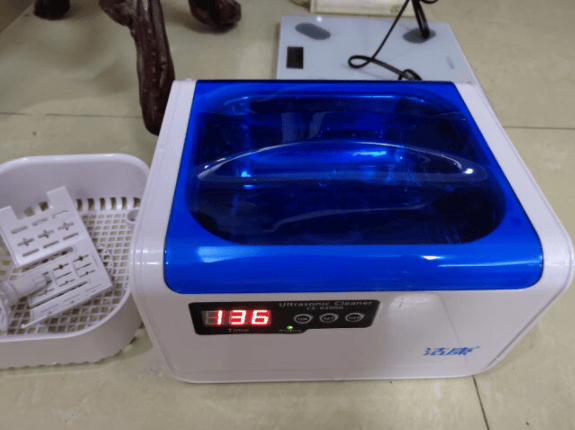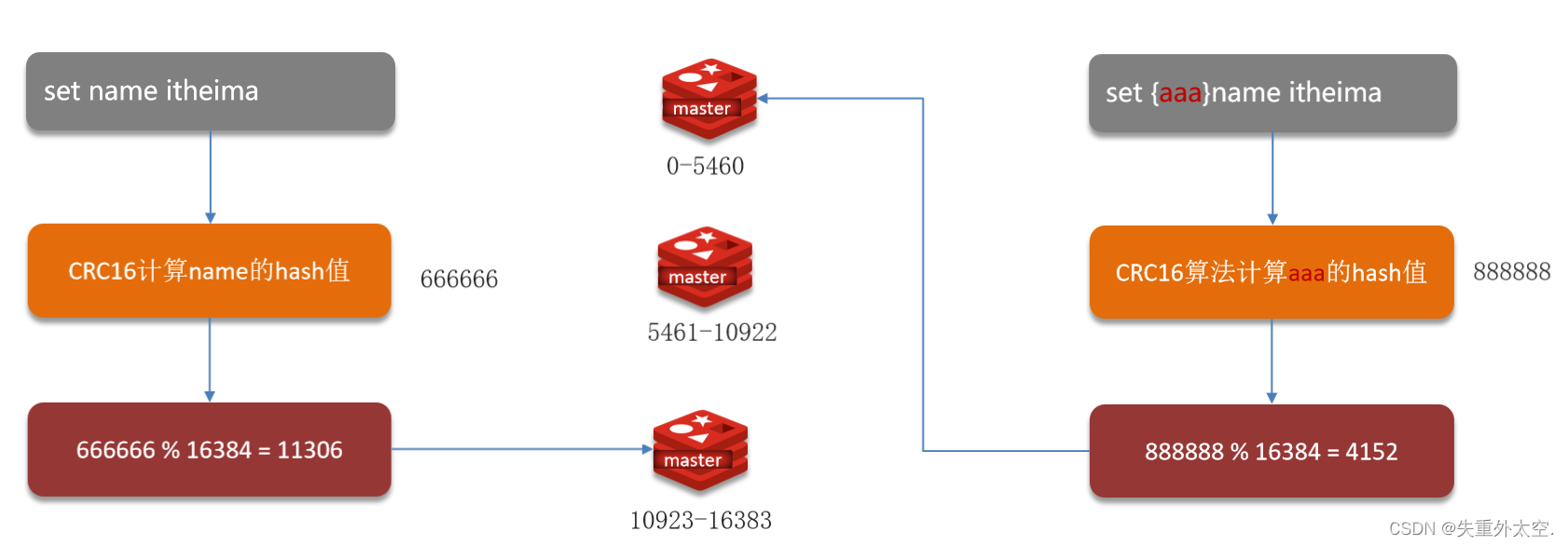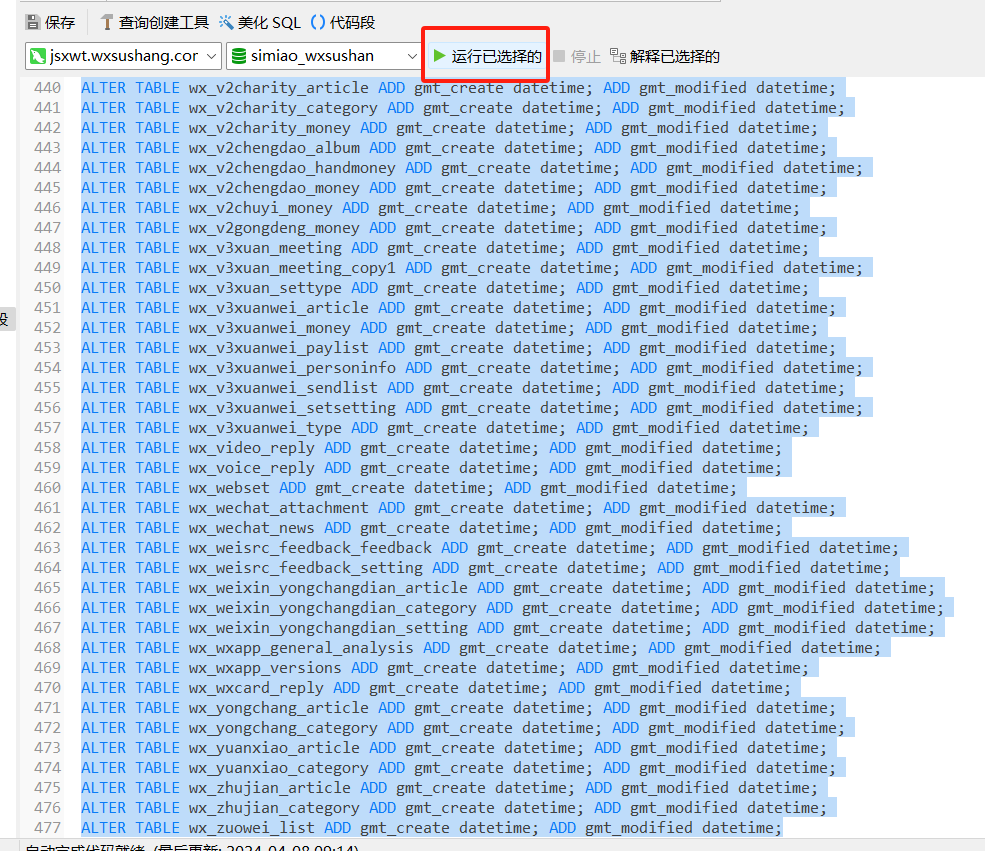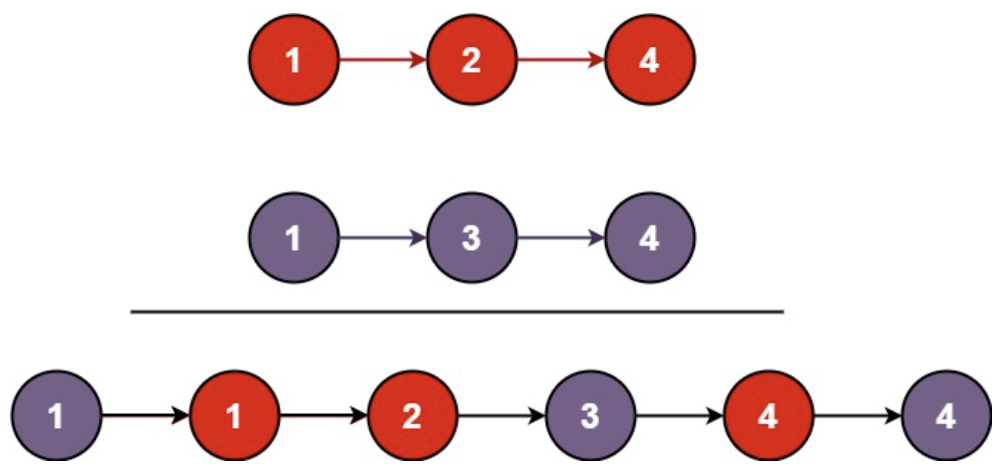背景
oracle
在适配过程中,发现pro*c支持exec sql for :i update(or insert)语法,其功能是取代
for(;;)
{
update(or insert)语法;
}
其中i决定循环执行的次数,update(or insert)表示循环执行的次数。
我们在oracle环境下测试得到如下经验:
(1) char str[]一维数组在update更新时,在where条件中不能使用如下格式作为右值":str[1]"。如果出现这种情况,则报段错误。

测试代码如下:
#include <stdio.h>
#include <stdlib.h>
#include <string.h>
EXEC SQL INCLUDE sqlca;
EXEC SQL BEGIN DECLARE SECTION;
char *uid = "test/test@ip/test";
EXEC SQL END DECLARE SECTION;
int
main(void)
{
int i=2;
EXEC SQL WHENEVER SQLERROR continue;
char arr[26]="123456789";
EXEC SQL CONNECT :uid;
fprintf(stderr, "sqlerrm.sqlerrmc: %s\n", sqlca.sqlerrm.sqlerrmc);
EXEC SQL FOR :i update test set a = :arr where a = :arr[0] ;
fprintf(stderr, "sqlerrm.sqlerrmc: %s\n", sqlca.sqlerrm.sqlerrmc);
EXEC SQL commit;
fprintf(stderr, "sqlerrm.sqlerrmc: %s\n", sqlca.sqlerrm.sqlerrmc);
exit(0);
}
(2)其他类型如上使用时(int,long等),能正常更新
#include <stdio.h>
#include <stdlib.h>
#include <string.h>
EXEC SQL INCLUDE sqlca;
EXEC SQL BEGIN DECLARE SECTION;
char *uid = "test/test@ip/test";
EXEC SQL END DECLARE SECTION;
int
main(void)
{
int i=2;
EXEC SQL WHENEVER SQLERROR continue;
int arr[26]={1,2,3,4,5,6,7,8,9,10,11,12,13,14};
EXEC SQL CONNECT :uid;
fprintf(stderr, "sqlerrm.sqlerrmc: %s\n", sqlca.sqlerrm.sqlerrmc);
EXEC SQL FOR :i update test set a = :arr where a = :arr[1];
fprintf(stderr, "sqlerrm.sqlerrmc: %s\n", sqlca.sqlerrm.sqlerrmc);
EXEC SQL commit;
fprintf(stderr, "sqlerrm.sqlerrmc: %s\n", sqlca.sqlerrm.sqlerrmc);
exit(0);
}
(3)oracle支持的主变量类型如下:
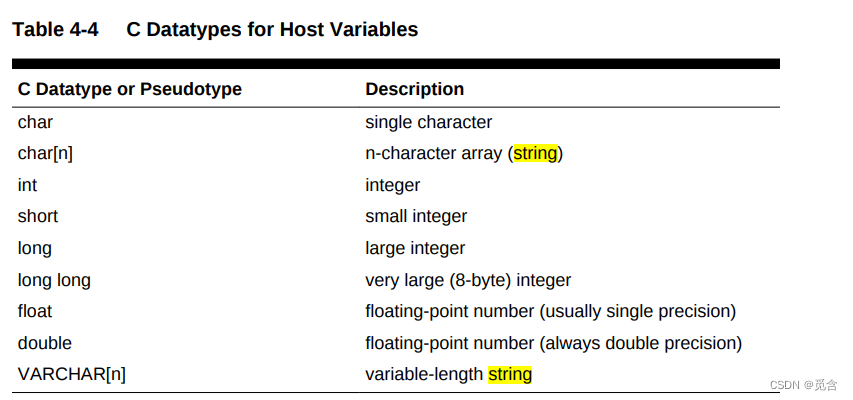
其中int、short、long、long long、float、double类型作为主变量只能声明成一维数组;

varchar类型作为主变量不能超过二维数组。

LightDB
LightDB在此基础之上进行兼容。在功能上,兼容上述oracle所描述的几点。并且由于LightDB支持的类型更多,因此需要多加一下几点说明:
(1)decimal、string、timestamp、date、interval、bool、numeric类型作为主变量只能声明成一维数组;
(2)varchar、bytea类型作为主变量使用只能声明成数组;并且声明成三维数组也会当成二维数组进行处理。
测试
正常测试
#include <stdio.h>
#include <stdlib.h>
#include <string.h>
EXEC SQL INCLUDE ../regression;
exec sql include ../../preproc/type.h;
#include <pgtypes_date.h>
#include <pgtypes_interval.h>
#include <pgtypes_numeric.h>
#include <pgtypes_timestamp.h>
exec sql type string is char[11];
typedef char string[11];
exec sql begin declare section;
/* 声明结构体 */
struct mixed_statements
{
/* 数值类型数值 */
int v_error_no[10];
numeric n[10];
short st[10];
long lg[10];
long long llg[10];
float ft[10];
double db[10];
decimal dl[10];
/* 字符串类型 */
char val[10][10];
varchar vc[10][10];
bytea ba[10][10];
char c[10];
string str_value[10];
/* 时间类型 */
timestamp ts[10];
date d[10];
interval inter[10];
/* 布尔类型 */
bool bl[10];
};
/* 字符串三维数组 */
struct string_declaration
{
/* 字符串类型 */
char val[10][10][10];
};
union u_mixed_statements
{
/* 数值类型数值 */
int v_error_no[10];
numeric n[10];
short st[10];
long lg[10];
long long llg[10];
float ft[10];
double db[10];
decimal dl[10];
/* 字符串类型 */
char val[10][10];
varchar vc[10][10];
bytea ba[10][10];
char c[10];
string str_value[10];
/* 时间类型 */
timestamp ts[10];
date d[10];
interval inter[10];
/* 布尔类型 */
bool bl[10];
};
/* 字符串三维数组 */
union u_string_declaration
{
/* 字符串类型 */
char val[10][10][10];
};
/* 结构体嵌套 */
struct nested_structure
{
struct mixed_statements *nsms;
struct string_declaration *nssd;
};
/* union嵌套 */
union nested_union
{
union u_mixed_statements u_nsms;
union u_string_declaration u_unssd;
};
exec sql end declare section;
static void
print_sqlca()
{
fprintf(stderr, "==== sqlca ====\n");
fprintf(stderr, "sqlcode: %ld\n", sqlca.sqlcode);
fprintf(stderr, "sqlerrm.sqlerrml: %d\n", sqlca.sqlerrm.sqlerrml);
fprintf(stderr, "sqlerrm.sqlerrmc: %s\n", sqlca.sqlerrm.sqlerrmc);
fprintf(stderr, "sqlstate: %5s\n", sqlca.sqlstate);
fprintf(stderr, "===============\n");
}
int main()
{
/* 声明主变量 */
exec sql begin declare section;
int v_error_no = 1;
char val[20] = "dsd";
numeric n;
timestamp ts;
date d;
short st =1;
long lg =1;
long long llg =1;
float ft=1;
double db=1;
bool bl= false;
varchar vc[100];
bytea ba[100];
string str_value = "string";
char c = 'a';
decimal dl;
interval inter;
struct mixed_statements *oda = NULL;
struct string_declaration *tda = NULL;
struct nested_structure *sns = NULL;
union u_mixed_statements uoda;
union u_string_declaration utda;
union nested_union snu;
int i, j = 0;
exec sql end declare section;
char str[10];
numeric *value;
oda = (struct mixed_statements* )malloc(sizeof(struct mixed_statements));
tda = (struct string_declaration* )malloc(sizeof(struct string_declaration));
/* 结构体嵌套赋初值 */
sns = (struct nested_structure* )malloc(sizeof(struct nested_structure));
sns->nsms = (struct mixed_statements* )malloc(sizeof(struct mixed_statements));
sns->nssd = (struct string_declaration* )malloc(sizeof(struct string_declaration));
/* ----------------------------普通变量赋值---------------------------- */
/* timestampe类型赋初值 */
sprintf(str, "2000-1-1 0%d:00:00\n", 1);
ts = PGTYPEStimestamp_from_asc(str, NULL);
/* date类型赋初值 */
sprintf(str, "2000-1-1%d\n", 1);
d = PGTYPESdate_from_asc(str, NULL);
/* interval类型赋初值 */
sprintf(str, "%d hours\n", 11);
inter = *PGTYPESinterval_from_asc(str, NULL);
/* numeric类型赋初值 */
value = PGTYPESnumeric_new();
PGTYPESnumeric_from_int(1, value);
/* decimal类型赋初值 */
n = *value;
PGTYPESnumeric_to_decimal(value, &dl);
/* varchar数组赋初值 */
memcpy(vc.arr, "abc", 10);
vc.len = 10;
/* bytea数组赋初值 */
memcpy(ba.arr, "aaaa", 10);
ba.len = 10;
memcpy(oda->c, "11111111\n", 10);
memcpy(sns->nsms->c, "11111111\n", 10);
/* ----------------------------结构体混合数组赋值---------------------------- */
for(i = 0; i < 10; i++)
{
oda->v_error_no[i] = i;
sns->nsms->v_error_no[i] = i;
oda->st[i] = i;
sns->nsms->st[i] = i;
oda->lg[i] = i;
sns->nsms->lg[i] = i;
oda->llg[i] = i;
sns->nsms->llg[i] = i;
oda->ft[i] = i;
sns->nsms->ft[i] = i;
oda->db[i] = i;
sns->nsms->db[i] = i;
oda->bl[i] = false;
sns->nsms->bl[i] = false;
sprintf(str, "dsd%d\n", i);
memcpy(oda->val[i], str, 10);
memcpy(sns->nsms->val[i], str, 10);
sprintf(str, "string%d\n", i);
memcpy(oda->str_value[i], str, 10);
memcpy(sns->nsms->str_value[i], str, 10);
/* timestampe类型赋初值 */
sprintf(str, "2000-1-1 0%d:00:00\n", i);
oda->ts[i] = PGTYPEStimestamp_from_asc(str, NULL);
sns->nsms->ts[i] = PGTYPEStimestamp_from_asc(str, NULL);
/* date类型赋初值 */
sprintf(str, "2000-1-1%d\n", i);
oda->d[i] = PGTYPESdate_from_asc(str, NULL);
sns->nsms->d[i] = PGTYPESdate_from_asc(str, NULL);
/* interval类型赋初值 */
sprintf(str, "%d hours\n", i);
oda->inter[i] = *PGTYPESinterval_from_asc(str, NULL);
sns->nsms->inter[i] = *PGTYPESinterval_from_asc(str, NULL);
value = PGTYPESnumeric_new();
PGTYPESnumeric_from_int(i, value);
/* numeric类型赋初值 */
oda->n[i] = *value;
sns->nsms->n[i] = *value;
/* decimal类型赋初值 */
PGTYPESnumeric_to_decimal(value, &(oda->dl[i]));
PGTYPESnumeric_to_decimal(value, &(sns->nsms->dl[i]));
/* varchar数组赋初值 */
sprintf(str, "abc%d\n", i);
memcpy(oda->vc[i].arr, str, 10);
oda->vc[i].len = 10;
memcpy(sns->nsms->vc[i].arr, str, 10);
sns->nsms->vc[i].len = 10;
/* bytea数组赋初值 */
sprintf(str, "aaaa%d\n", i);
memcpy(oda->ba[i].arr, str, 10);
oda->ba[i].len = 10;
memcpy(sns->nsms->ba[i].arr, str, 10);
sns->nsms->ba[i].len = 10;
}
/* ----------------------------结构体三维数组赋值---------------------------- */
for(i = 0; i < 10; i++)
for(j = 0; j < 10; j++)
{
sprintf(str, "dsd%d\n", i);
memcpy(tda->val[i][j], str, 10);
memcpy(sns->nssd->val[i][j], str, 10);
}
/* 打开一个调试日志 */
ECPGdebug(1, stderr);
/* 连接数据库 */
EXEC SQL CONNECT TO oracledb;
/* 设置 waring 和 error 的处理方式 */
EXEC SQL WHENEVER SQLWARNING SQLPRINT;
EXEC SQL WHENEVER SQLERROR CALL print_sqlca();
/* -----------------------混合数组插入数据----------------------- */
{
/* 建表 */
exec sql create table test_for_count(
k1 integer,
k2 char(10),
k3 numeric,
k4 timestamp,
k5 date,
k6 smallint,
k7 bigint,
k8 bigint,
k9 real,
k10 double precision,
k11 bool,
k12 varchar(100),
k13 bytea,
k14 text,
k15 char,
k16 decimal,
k17 interval);
i = 5;
EXEC SQL for :i insert into test_for_count values
(:oda->v_error_no, :oda->val, :oda->n, :oda->ts, :oda->d,
:oda->st, :oda->lg, :oda->llg, :oda->ft, :oda->db, :oda->bl, :oda->vc,
:oda->ba, :oda->str_value, :oda->c, :oda->dl, :oda->inter);
i = 5;
EXEC SQL for :i update test_for_count set k1 = :oda->v_error_no, k2 = :oda->val, k3 = :oda->n,
k4 = :oda->ts, k5 = :oda->d, k6 = :oda->st, k7 = :oda->lg, k8 = :oda->llg, k9 = :oda->ft, k10 = :oda->db,
k11 = :oda->bl, k12 = :oda->vc, k13 = :oda->ba, k14 = :oda->str_value, k15 = :oda->c,
k16 = :oda->dl, k17 = :oda->inter;
/* 声明游标 */
EXEC SQL DECLARE cur_for_count_insert CURSOR FOR select * from test_for_count;
/* 打开游标 */
EXEC SQL OPEN cur_for_count_insert;
/* 在达到结果集末尾时,跳出 while 循环 */
EXEC SQL WHENEVER NOT FOUND DO BREAK;
printf("-----------------------Mixed Array Output-----------------------\n");
/* 游标获取打印 */
while(1)
{
EXEC SQL FETCH cur_for_count_insert INTO :v_error_no, :val, :n, :ts, :d, :st, :lg, :llg, :ft, :db, :bl, :vc, :ba, :str_value, :c, :dl, :inter;
PGTYPESnumeric_from_decimal(&dl, value);
printf("-----------------------Get result set-----------------------\n");
printf("k1 = %d\nk2 = %s\nk3 = %s\nk4 = %s\nk5 = %s\nk6 = %d\nk7 = %ld\nk8 = %lld\nk9 = %f\nk10 = %f\nk11 = %d\nk12 = %s\nk13 = %s\nk14 = %s\nk15 = %d\nk16 = %s\nk17 = %s\n",
v_error_no, val, PGTYPESnumeric_to_asc(&n, -1), PGTYPEStimestamp_to_asc(ts), PGTYPESdate_to_asc(d), st, lg, llg, ft, db, bl, vc.arr, ba.arr, str_value, c, PGTYPESnumeric_to_asc(value, -1), PGTYPESinterval_to_asc(&inter));
}
/* 关闭游标 */
EXEC SQL CLOSE cur_for_count_insert;
EXEC SQL DROP TABLE test_for_count;
}
/* -----------------------三维数组插入数据----------------------- */
{
/* 建表 */
exec sql create table test_for_count(
k1 integer,
k2 char(10),
k3 numeric,
k4 timestamp,
k5 date,
k6 smallint,
k7 bigint,
k8 bigint,
k9 real,
k10 double precision,
k11 bool,
k12 varchar(100),
k13 bytea,
k14 text,
k15 char,
k16 decimal,
k17 interval);
i = 5;
EXEC SQL for :i insert into test_for_count values
(:oda->v_error_no, :tda->val, :oda->n, :oda->ts, :oda->d,
:oda->st, :oda->lg, :oda->llg, :oda->ft, :oda->db, :oda->bl, :oda->vc,
:oda->ba, :oda->str_value, :oda->c, :oda->dl, :oda->inter);
i = 5;
EXEC SQL for :i update test_for_count set k1 = :oda->v_error_no, k2 = :oda->val, k3 = :oda->n,
k4 = :oda->ts, k5 = :oda->d, k6 = :oda->st, k7 = :oda->lg, k8 = :oda->llg, k9 = :oda->ft, k10 = :oda->db,
k11 = :oda->bl, k12 = :oda->vc, k13 = :oda->ba, k14 = :oda->str_value, k15 = :oda->c,
k16 = :oda->dl, k17 = :oda->inter;
/* 声明游标 */
EXEC SQL DECLARE cur_for_count_insert CURSOR FOR select * from test_for_count;
/* 打开游标 */
EXEC SQL OPEN cur_for_count_insert;
printf("-----------------------3-Dimensional Array Output-----------------------\n");
/* 游标获取打印 */
while(1)
{
EXEC SQL FETCH cur_for_count_insert INTO :v_error_no, :val, :n, :ts, :d, :st, :lg, :llg, :ft, :db, :bl, :vc, :ba, :str_value, :c, :dl, :inter;
PGTYPESnumeric_from_decimal(&dl, value);
printf("-----------------------Get result set-----------------------\n");
printf("k1 = %d\nk2 = %s\nk3 = %s\nk4 = %s\nk5 = %s\nk6 = %d\nk7 = %ld\nk8 = %lld\nk9 = %f\nk10 = %f\nk11 = %d\nk12 = %s\nk13 = %s\nk14 = %s\nk15 = %d\nk16 = %s\nk17 = %s\n",
v_error_no, val, PGTYPESnumeric_to_asc(&n, -1), PGTYPEStimestamp_to_asc(ts), PGTYPESdate_to_asc(d), st, lg, llg, ft, db, bl, vc.arr, ba.arr, str_value, c, PGTYPESnumeric_to_asc(value, -1), PGTYPESinterval_to_asc(&inter));
}
/* 关闭游标 */
EXEC SQL CLOSE cur_for_count_insert;
EXEC SQL DROP TABLE test_for_count;
}
/* -----------------------结构体嵌套插入数据----------------------- */
{
/* 建表 */
exec sql create table test_for_count(
k1 integer,
k2 char(10),
k3 numeric,
k4 timestamp,
k5 date,
k6 smallint,
k7 bigint,
k8 bigint,
k9 real,
k10 double precision,
k11 bool,
k12 varchar(100),
k13 bytea,
k14 text,
k15 char,
k16 decimal,
k17 interval);
i = 5;
EXEC SQL for :i insert into test_for_count values
(:sns->nsms->v_error_no, :sns->nssd->val, :sns->nsms->n, :sns->nsms->ts, :sns->nsms->d,
:sns->nsms->st, :sns->nsms->lg, :sns->nsms->llg, :sns->nsms->ft, :sns->nsms->db, :sns->nsms->bl, :sns->nsms->vc,
:sns->nsms->ba, :sns->nsms->str_value, :sns->nsms->c, :sns->nsms->dl, :sns->nsms->inter);
i = 5;
EXEC SQL for :i update test_for_count set k1 = :sns->nsms->v_error_no, k2 = :sns->nsms->val, k3 = :sns->nsms->n,
k4 = :sns->nsms->ts, k5 = :sns->nsms->d, k6 = :sns->nsms->st, k7 = :sns->nsms->lg, k8 = :sns->nsms->llg, k9 = :sns->nsms->ft, k10 = :sns->nsms->db,
k11 = :sns->nsms->bl, k12 = :sns->nsms->vc, k13 = :sns->nsms->ba, k14 = :sns->nsms->str_value, k15 = :sns->nsms->c,
k16 = :sns->nsms->dl, k17 = :sns->nsms->inter;
/* 声明游标 */
EXEC SQL DECLARE cur_for_count_insert CURSOR FOR select * from test_for_count;
/* 打开游标 */
EXEC SQL OPEN cur_for_count_insert;
printf("-----------------------Structures Nested Output-----------------------\n");
/* 游标获取打印 */
while(1)
{
EXEC SQL FETCH cur_for_count_insert INTO :v_error_no, :val, :n, :ts, :d, :st, :lg, :llg, :ft, :db, :bl, :vc, :ba, :str_value, :c, :dl, :inter;
PGTYPESnumeric_from_decimal(&dl, value);
printf("-----------------------Get result set-----------------------\n");
printf("k1 = %d\nk2 = %s\nk3 = %s\nk4 = %s\nk5 = %s\nk6 = %d\nk7 = %ld\nk8 = %lld\nk9 = %f\nk10 = %f\nk11 = %d\nk12 = %s\nk13 = %s\nk14 = %s\nk15 = %d\nk16 = %s\nk17 = %s\n",
v_error_no, val, PGTYPESnumeric_to_asc(&n, -1), PGTYPEStimestamp_to_asc(ts), PGTYPESdate_to_asc(d), st, lg, llg, ft, db, bl, vc.arr, ba.arr, str_value, c, PGTYPESnumeric_to_asc(value, -1), PGTYPESinterval_to_asc(&inter));
}
/* 关闭游标 */
EXEC SQL CLOSE cur_for_count_insert;
EXEC SQL DROP TABLE test_for_count;
}
/* -----------------------union混合数组插入数据----------------------- */
{
/* -----------------int类型测试----------------- */
{
for(i = 0; i < 10; i++)
{
uoda.v_error_no[i] = i + 1;
}
/* 建表 */
exec sql create table test_for_count(
k1 integer,
k2 char(10),
k3 numeric,
k4 timestamp,
k5 date,
k6 smallint,
k7 bigint,
k8 bigint,
k9 real,
k10 double precision,
k11 bool,
k12 varchar(100),
k13 bytea,
k14 text,
k15 char,
k16 decimal,
k17 interval);
i = 3;
EXEC SQL for :i insert into test_for_count(k1) values
(:uoda.v_error_no);
i = 2;
EXEC SQL for :i update test_for_count set k1 = :uoda.v_error_no where k1 = 3;
/* 声明游标 */
EXEC SQL DECLARE cur_for_count_insert CURSOR FOR select k1 from test_for_count order by k1 asc;
/* 打开游标 */
EXEC SQL OPEN cur_for_count_insert;
printf("-----------------------union mixed array output-----------------------\n");
printf("-----------------------test of int type-----------------------\n");
/* 游标获取打印 */
while(1)
{
EXEC SQL FETCH cur_for_count_insert INTO :v_error_no;
printf("k1 = %d\n", v_error_no);
}
/* 关闭游标 */
EXEC SQL CLOSE cur_for_count_insert;
/* 清理环境 */
EXEC SQL DROP table test_for_count;
/*----------------------------------test of int .var[]----------------------------------*/
/* 建表 */
exec sql create table test_for_count(
k1 integer,
k2 char(10),
k3 numeric,
k4 timestamp,
k5 date,
k6 smallint,
k7 bigint,
k8 bigint,
k9 real,
k10 double precision,
k11 bool,
k12 varchar(100),
k13 bytea,
k14 text,
k15 char,
k16 decimal,
k17 interval);
i = 3;
EXEC SQL for :i insert into test_for_count(k1) values
(:uoda.v_error_no);
i = 2;
EXEC SQL for :i update test_for_count set k1 = :uoda.v_error_no where k1 = :uoda.v_error_no[1];
/* 声明游标 */
EXEC SQL DECLARE cur_for_count_insert CURSOR FOR select k1 from test_for_count order by k1 asc;
/* 打开游标 */
EXEC SQL OPEN cur_for_count_insert;
printf("-----------------------test of int .var[]-----------------------\n");
/* 游标获取打印 */
while(1)
{
EXEC SQL FETCH cur_for_count_insert INTO :v_error_no;
printf("k1 = %d\n", v_error_no);
}
/* 关闭游标 */
EXEC SQL CLOSE cur_for_count_insert;
/* 清理环境 */
EXEC SQL DROP table test_for_count;
}
/* -----------------char类型测试----------------- */
{
for(i = 0; i < 10; i++)
{
sprintf(str, "dsd%d\n", i);
memcpy(uoda.val[i], str, 10);
}
/* 建表 */
exec sql create table test_for_count(
k1 integer,
k2 char(10),
k3 numeric,
k4 timestamp,
k5 date,
k6 smallint,
k7 bigint,
k8 bigint,
k9 real,
k10 double precision,
k11 bool,
k12 varchar(100),
k13 bytea,
k14 text,
k15 char,
k16 decimal,
k17 interval);
i = 3;
EXEC SQL for :i insert into test_for_count(k2) values
(:uoda.val);
i = 2;
EXEC SQL for :i update test_for_count set k2 = :uoda.val where k2 = :uoda.val[1];
/* 声明游标 */
EXEC SQL DECLARE cur_for_count_insert CURSOR FOR select k2 from test_for_count order by k2 asc;
/* 打开游标 */
EXEC SQL OPEN cur_for_count_insert;
printf("-----------------------test of char type-----------------------\n");
/* 游标获取打印 */
while(1)
{
EXEC SQL FETCH cur_for_count_insert INTO :val;
printf("k2 = %s\n", val);
}
/* 关闭游标 */
EXEC SQL CLOSE cur_for_count_insert;
/* 清理环境 */
EXEC SQL DROP table test_for_count;
}
/* -----------------numeric类型测试----------------- */
{
for(i = 0; i < 10; i++)
{
value = PGTYPESnumeric_new();
PGTYPESnumeric_from_int(i, value);
/* numeric类型赋初值 */
uoda.n[i] = *value;
}
/* 建表 */
exec sql create table test_for_count(
k1 integer,
k2 char(10),
k3 numeric,
k4 timestamp,
k5 date,
k6 smallint,
k7 bigint,
k8 bigint,
k9 real,
k10 double precision,
k11 bool,
k12 varchar(100),
k13 bytea,
k14 text,
k15 char,
k16 decimal,
k17 interval);
i = 3;
EXEC SQL for :i insert into test_for_count(k3) values
(:uoda.n);
i = 2;
EXEC SQL for :i update test_for_count set k3 = :uoda.n where k3 = :uoda.n[1];
/* 声明游标 */
EXEC SQL DECLARE cur_for_count_insert CURSOR FOR select k3 from test_for_count order by k3 asc;
/* 打开游标 */
EXEC SQL OPEN cur_for_count_insert;
printf("-----------------------test of numeric type-----------------------\n");
/* 游标获取打印 */
while(1)
{
EXEC SQL FETCH cur_for_count_insert INTO :n;
printf("k3 = %s\n", PGTYPESnumeric_to_asc(&n, -1));
}
/* 关闭游标 */
EXEC SQL CLOSE cur_for_count_insert;
/* 清理环境 */
EXEC SQL DROP table test_for_count;
}
/* -----------------timestamp类型测试----------------- */
{
for(i = 0; i < 10; i++)
{
sprintf(str, "2000-1-1 0%d:00:00\n", i);
uoda.ts[i] = PGTYPEStimestamp_from_asc(str, NULL);
}
/* 建表 */
exec sql create table test_for_count(
k1 integer,
k2 char(10),
k3 numeric,
k4 timestamp,
k5 date,
k6 smallint,
k7 bigint,
k8 bigint,
k9 real,
k10 double precision,
k11 bool,
k12 varchar(100),
k13 bytea,
k14 text,
k15 char,
k16 decimal,
k17 interval);
i = 3;
EXEC SQL for :i insert into test_for_count(k4) values
(:uoda.ts);
i = 2;
EXEC SQL for :i update test_for_count set k4 = :uoda.ts where k4 = :uoda.ts[1];
/* 声明游标 */
EXEC SQL DECLARE cur_for_count_insert CURSOR FOR select k4 from test_for_count order by k4 asc;
/* 打开游标 */
EXEC SQL OPEN cur_for_count_insert;
printf("-----------------------test of timestamp type-----------------------\n");
/* 游标获取打印 */
while(1)
{
EXEC SQL FETCH cur_for_count_insert INTO :ts;
printf("k4 = %s\n", PGTYPEStimestamp_to_asc(ts));
}
/* 关闭游标 */
EXEC SQL CLOSE cur_for_count_insert;
/* 清理环境 */
EXEC SQL DROP table test_for_count;
}
/* -----------------date类型测试----------------- */
{
for(i = 0; i < 10; i++)
{
sprintf(str, "2000-1-1%d\n", i);
uoda.d[i] = PGTYPESdate_from_asc(str, NULL);
}
/* 建表 */
exec sql create table test_for_count(
k1 integer,
k2 char(10),
k3 numeric,
k4 timestamp,
k5 date,
k6 smallint,
k7 bigint,
k8 bigint,
k9 real,
k10 double precision,
k11 bool,
k12 varchar(100),
k13 bytea,
k14 text,
k15 char,
k16 decimal,
k17 interval);
i = 3;
EXEC SQL for :i insert into test_for_count(k5) values
(:uoda.d);
i = 2;
EXEC SQL for :i update test_for_count set k5 = :uoda.d where k5 = :uoda.d[1];
/* 声明游标 */
EXEC SQL DECLARE cur_for_count_insert CURSOR FOR select k5 from test_for_count order by k5 asc;
/* 打开游标 */
EXEC SQL OPEN cur_for_count_insert;
printf("-----------------------test of date type-----------------------\n");
/* 游标获取打印 */
while(1)
{
EXEC SQL FETCH cur_for_count_insert INTO :d;
printf("k5 = %s\n", PGTYPESdate_to_asc(d));
}
/* 关闭游标 */
EXEC SQL CLOSE cur_for_count_insert;
/* 清理环境 */
EXEC SQL DROP table test_for_count;
}
/* -----------------short类型测试----------------- */
{
for(i = 0; i < 10; i++)
{
uoda.st[i] = i;
}
/* 建表 */
exec sql create table test_for_count(
k1 integer,
k2 char(10),
k3 numeric,
k4 timestamp,
k5 date,
k6 smallint,
k7 bigint,
k8 bigint,
k9 real,
k10 double precision,
k11 bool,
k12 varchar(100),
k13 bytea,
k14 text,
k15 char,
k16 decimal,
k17 interval);
i = 3;
EXEC SQL for :i insert into test_for_count(k6) values
(:uoda.st);
i = 2;
EXEC SQL for :i update test_for_count set k6 = :uoda.st where k6 = :uoda.st[1];
/* 声明游标 */
EXEC SQL DECLARE cur_for_count_insert CURSOR FOR select k6 from test_for_count order by k6 asc;
/* 打开游标 */
EXEC SQL OPEN cur_for_count_insert;
printf("-----------------------test of numeric type-----------------------\n");
/* 游标获取打印 */
while(1)
{
EXEC SQL FETCH cur_for_count_insert INTO :st;
printf("k6 = %d\n", st);
}
/* 关闭游标 */
EXEC SQL CLOSE cur_for_count_insert;
/* 清理环境 */
EXEC SQL DROP table test_for_count;
}
/* -----------------long类型测试----------------- */
{
for(i = 0; i < 10; i++)
{
uoda.lg[i] = i;
}
/* 建表 */
exec sql create table test_for_count(
k1 integer,
k2 char(10),
k3 numeric,
k4 timestamp,
k5 date,
k6 smallint,
k7 bigint,
k8 bigint,
k9 real,
k10 double precision,
k11 bool,
k12 varchar(100),
k13 bytea,
k14 text,
k15 char,
k16 decimal,
k17 interval);
i = 3;
EXEC SQL for :i insert into test_for_count(k7) values
(:uoda.lg);
i = 2;
EXEC SQL for :i update test_for_count set k7 = :uoda.lg where k7 = :uoda.lg[1];
/* 声明游标 */
EXEC SQL DECLARE cur_for_count_insert CURSOR FOR select k7 from test_for_count order by k7 asc;
/* 打开游标 */
EXEC SQL OPEN cur_for_count_insert;
printf("-----------------------test of long type-----------------------\n");
/* 游标获取打印 */
while(1)
{
EXEC SQL FETCH cur_for_count_insert INTO :lg;
printf("k7 = %ld\n", lg);
}
/* 关闭游标 */
EXEC SQL CLOSE cur_for_count_insert;
/* 清理环境 */
EXEC SQL DROP table test_for_count;
}
/* -----------------long long类型测试----------------- */
{
for(i = 0; i < 10; i++)
{
uoda.llg[i] = i;
}
/* 建表 */
exec sql create table test_for_count(
k1 integer,
k2 char(10),
k3 numeric,
k4 timestamp,
k5 date,
k6 smallint,
k7 bigint,
k8 bigint,
k9 real,
k10 double precision,
k11 bool,
k12 varchar(100),
k13 bytea,
k14 text,
k15 char,
k16 decimal,
k17 interval);
i = 3;
EXEC SQL for :i insert into test_for_count(k8) values
(:uoda.llg);
i = 2;
EXEC SQL for :i update test_for_count set k8 = :uoda.llg where k8 = :uoda.llg[1];
/* 声明游标 */
EXEC SQL DECLARE cur_for_count_insert CURSOR FOR select k8 from test_for_count order by k8 asc;
/* 打开游标 */
EXEC SQL OPEN cur_for_count_insert;
printf("-----------------------test of long long type-----------------------\n");
/* 游标获取打印 */
while(1)
{
EXEC SQL FETCH cur_for_count_insert INTO :llg;
printf("k8 = %lld\n", llg);
}
/* 关闭游标 */
EXEC SQL CLOSE cur_for_count_insert;
/* 清理环境 */
EXEC SQL DROP table test_for_count;
}
/* -----------------float类型测试----------------- */
{
for(i = 0; i < 10; i++)
{
uoda.ft[i] = i;
}
/* 建表 */
exec sql create table test_for_count(
k1 integer,
k2 char(10),
k3 numeric,
k4 timestamp,
k5 date,
k6 smallint,
k7 bigint,
k8 bigint,
k9 real,
k10 double precision,
k11 bool,
k12 varchar(100),
k13 bytea,
k14 text,
k15 char,
k16 decimal,
k17 interval);
i = 3;
EXEC SQL for :i insert into test_for_count(k9) values
(:uoda.ft);
i = 2;
EXEC SQL for :i update test_for_count set k9 = :uoda.ft where k9 = :uoda.ft[1];
/* 声明游标 */
EXEC SQL DECLARE cur_for_count_insert CURSOR FOR select k9 from test_for_count order by k9 asc;
/* 打开游标 */
EXEC SQL OPEN cur_for_count_insert;
printf("-----------------------test of float type-----------------------\n");
/* 游标获取打印 */
while(1)
{
EXEC SQL FETCH cur_for_count_insert INTO :ft;
printf("k9 = %f\n", ft);
}
/* 关闭游标 */
EXEC SQL CLOSE cur_for_count_insert;
/* 清理环境 */
EXEC SQL DROP table test_for_count;
}
/* -----------------double类型测试----------------- */
{
for(i = 0; i < 10; i++)
{
uoda.db[i] = i;
}
/* 建表 */
exec sql create table test_for_count(
k1 integer,
k2 char(10),
k3 numeric,
k4 timestamp,
k5 date,
k6 smallint,
k7 bigint,
k8 bigint,
k9 real,
k10 double precision,
k11 bool,
k12 varchar(100),
k13 bytea,
k14 text,
k15 char,
k16 decimal,
k17 interval);
i = 3;
EXEC SQL for :i insert into test_for_count(k10) values
(:uoda.db);
i = 2;
EXEC SQL for :i update test_for_count set k10 = :uoda.db where k10 = :uoda.db[1];
/* 声明游标 */
EXEC SQL DECLARE cur_for_count_insert CURSOR FOR select k10 from test_for_count order by k10 asc;
/* 打开游标 */
EXEC SQL OPEN cur_for_count_insert;
printf("-----------------------test of double type-----------------------\n");
/* 游标获取打印 */
while(1)
{
EXEC SQL FETCH cur_for_count_insert INTO :db;
printf("k10 = %f\n", db);
}
/* 关闭游标 */
EXEC SQL CLOSE cur_for_count_insert;
/* 清理环境 */
EXEC SQL DROP table test_for_count;
}
/* -----------------varchar类型测试----------------- */
{
for(i = 0; i < 10; i++)
{
sprintf(str, "abc%d\n", i);
memcpy(uoda.vc[i].arr, str, 10);
uoda.vc[i].len = 10;
}
/* 建表 */
exec sql create table test_for_count(
k1 integer,
k2 char(10),
k3 numeric,
k4 timestamp,
k5 date,
k6 smallint,
k7 bigint,
k8 bigint,
k9 real,
k10 double precision,
k11 bool,
k12 varchar(100),
k13 bytea,
k14 text,
k15 char,
k16 decimal,
k17 interval);
i = 3;
EXEC SQL for :i insert into test_for_count(k12) values
(:uoda.vc);
i = 2;
EXEC SQL for :i update test_for_count set k12 = :uoda.vc where k12 = :uoda.vc[1];
/* 声明游标 */
EXEC SQL DECLARE cur_for_count_insert CURSOR FOR select k12 from test_for_count order by k12 asc;
/* 打开游标 */
EXEC SQL OPEN cur_for_count_insert;
printf("-----------------------test of varchar type-----------------------\n");
/* 游标获取打印 */
while(1)
{
EXEC SQL FETCH cur_for_count_insert INTO :vc;
printf("k12 = %s\n", vc.arr);
}
/* 关闭游标 */
EXEC SQL CLOSE cur_for_count_insert;
/* 清理环境 */
EXEC SQL DROP table test_for_count;
}
/* -----------------bytea类型测试----------------- */
{
for(i = 0; i < 10; i++)
{
sprintf(str, "aaaa%d\n", i);
memcpy(uoda.ba[i].arr, str, 10);
uoda.ba[i].len = 10;
}
/* 建表 */
exec sql create table test_for_count(
k1 integer,
k2 char(10),
k3 numeric,
k4 timestamp,
k5 date,
k6 smallint,
k7 bigint,
k8 bigint,
k9 real,
k10 double precision,
k11 bool,
k12 varchar(100),
k13 bytea,
k14 text,
k15 char,
k16 decimal,
k17 interval);
i = 3;
EXEC SQL for :i insert into test_for_count(k13) values
(:uoda.ba);
i = 2;
EXEC SQL for :i update test_for_count set k13 = :uoda.ba where k13 = :uoda.ba[1];
/* 声明游标 */
EXEC SQL DECLARE cur_for_count_insert CURSOR FOR select k13 from test_for_count order by k13 asc;
/* 打开游标 */
EXEC SQL OPEN cur_for_count_insert;
printf("-----------------------test of bytea type-----------------------\n");
/* 游标获取打印 */
while(1)
{
EXEC SQL FETCH cur_for_count_insert INTO :ba;
printf("k13 = %s\n", ba.arr);
}
/* 关闭游标 */
EXEC SQL CLOSE cur_for_count_insert;
/* 清理环境 */
EXEC SQL DROP table test_for_count;
}
/* -----------------string类型测试----------------- */
{
for(i = 0; i < 10; i++)
{
sprintf(str, "string%d\n", i);
memcpy(uoda.str_value[i], str, 10);
}
/* 建表 */
exec sql create table test_for_count(
k1 integer,
k2 char(10),
k3 numeric,
k4 timestamp,
k5 date,
k6 smallint,
k7 bigint,
k8 bigint,
k9 real,
k10 double precision,
k11 bool,
k12 varchar(100),
k13 bytea,
k14 text,
k15 char,
k16 decimal,
k17 interval);
i = 3;
EXEC SQL for :i insert into test_for_count(k14) values
(:uoda.str_value);
i = 2;
EXEC SQL for :i update test_for_count set k14 = :uoda.str_value where k14 = :uoda.str_value[1];
/* 声明游标 */
EXEC SQL DECLARE cur_for_count_insert CURSOR FOR select k14 from test_for_count order by k14 asc;
/* 打开游标 */
EXEC SQL OPEN cur_for_count_insert;
printf("-----------------------test of string type-----------------------\n");
/* 游标获取打印 */
while(1)
{
EXEC SQL FETCH cur_for_count_insert INTO :str_value;
printf("k14 = %s\n", str_value);
}
/* 关闭游标 */
EXEC SQL CLOSE cur_for_count_insert;
/* 清理环境 */
EXEC SQL DROP table test_for_count;
}
/* -----------------decimal类型测试----------------- */
{
for(i = 0; i < 10; i++)
{
value = PGTYPESnumeric_new();
PGTYPESnumeric_from_int(i, value);
/* decimal类型赋初值 */
PGTYPESnumeric_to_decimal(value, &(uoda.dl[i]));
}
/* 建表 */
exec sql create table test_for_count(
k1 integer,
k2 char(10),
k3 numeric,
k4 timestamp,
k5 date,
k6 smallint,
k7 bigint,
k8 bigint,
k9 real,
k10 double precision,
k11 bool,
k12 varchar(100),
k13 bytea,
k14 text,
k15 char,
k16 decimal,
k17 interval);
i = 3;
EXEC SQL for :i insert into test_for_count(k16) values
(:uoda.dl);
i = 2;
EXEC SQL for :i update test_for_count set k16 = :uoda.dl where k16 = :uoda.dl[1];
/* 声明游标 */
EXEC SQL DECLARE cur_for_count_insert CURSOR FOR select k16 from test_for_count order by k16 asc;
/* 打开游标 */
EXEC SQL OPEN cur_for_count_insert;
printf("-----------------------test of decimal type-----------------------\n");
/* 游标获取打印 */
while(1)
{
EXEC SQL FETCH cur_for_count_insert INTO :dl;
PGTYPESnumeric_from_decimal(&dl, value);
printf("k16 = %s\n", PGTYPESnumeric_to_asc(value, -1));
}
/* 关闭游标 */
EXEC SQL CLOSE cur_for_count_insert;
/* 清理环境 */
EXEC SQL DROP table test_for_count;
}
/* -----------------interval类型测试----------------- */
{
for(i = 0; i < 10; i++)
{
sprintf(str, "%d hours\n", i);
uoda.inter[i] = *PGTYPESinterval_from_asc(str, NULL);
}
/* 建表 */
exec sql create table test_for_count(
k1 integer,
k2 char(10),
k3 numeric,
k4 timestamp,
k5 date,
k6 smallint,
k7 bigint,
k8 bigint,
k9 real,
k10 double precision,
k11 bool,
k12 varchar(100),
k13 bytea,
k14 text,
k15 char,
k16 decimal,
k17 interval);
i = 3;
EXEC SQL for :i insert into test_for_count(k17) values
(:uoda.inter);
i = 2;
EXEC SQL for :i update test_for_count set k17 = :uoda.inter where k17 = :uoda.inter[1];
/* 声明游标 */
EXEC SQL DECLARE cur_for_count_insert CURSOR FOR select k17 from test_for_count order by k17 asc;
/* 打开游标 */
EXEC SQL OPEN cur_for_count_insert;
printf("-----------------------test of interval type-----------------------\n");
/* 游标获取打印 */
while(1)
{
EXEC SQL FETCH cur_for_count_insert INTO :inter;
printf("k17 = %s\n", PGTYPESinterval_to_asc(&inter));
}
/* 关闭游标 */
EXEC SQL CLOSE cur_for_count_insert;
/* 清理环境 */
EXEC SQL DROP table test_for_count;
}
}
/* -----------------------union三维数组插入数据----------------------- */
/* -----------------char类型测试----------------- */
{
for(i = 0; i < 10; i++)
for(j = 0; j < 10; j++)
{
sprintf(str, "dsd%d\n", i);
memcpy(utda.val[i][j], str, 10);
}
/* 建表 */
exec sql create table test_for_count(
k1 integer,
k2 char(10),
k3 numeric,
k4 timestamp,
k5 date,
k6 smallint,
k7 bigint,
k8 bigint,
k9 real,
k10 double precision,
k11 bool,
k12 varchar(100),
k13 bytea,
k14 text,
k15 char,
k16 decimal,
k17 interval);
i = 3;
EXEC SQL for :i insert into test_for_count(k2) values
(:utda.val);
i = 2;
EXEC SQL for :i update test_for_count set k2 = :utda.val where k2 = :utda.val[1];
/* 声明游标 */
EXEC SQL DECLARE cur_for_count_insert CURSOR FOR select k2 from test_for_count order by k2 asc;
/* 打开游标 */
EXEC SQL OPEN cur_for_count_insert;
printf("-----------------------union 3-Dimensional array output-----------------------\n");
printf("-----------------------test of char type-----------------------\n");
/* 游标获取打印 */
while(1)
{
EXEC SQL FETCH cur_for_count_insert INTO :val;
printf("k2 = %s\n", val);
}
/* 关闭游标 */
EXEC SQL CLOSE cur_for_count_insert;
/* 清理环境 */
EXEC SQL DROP table test_for_count;
}
/* -----------------------union嵌套插入数据----------------------- */
/* -----------------char类型测试----------------- */
{
for(i = 0; i < 10; i++)
for(j = 0; j < 10; j++)
{
sprintf(str, "dsd%d\n", i);
memcpy(snu.u_unssd.val[i][j], str, 10);
}
/* 建表 */
exec sql create table test_for_count(
k1 integer,
k2 char(10),
k3 numeric,
k4 timestamp,
k5 date,
k6 smallint,
k7 bigint,
k8 bigint,
k9 real,
k10 double precision,
k11 bool,
k12 varchar(100),
k13 bytea,
k14 text,
k15 char,
k16 decimal,
k17 interval);
i = 3;
EXEC SQL for :i insert into test_for_count(k2) values
(:snu.u_unssd.val);
i = 2;
EXEC SQL for :i update test_for_count set k2 = :snu.u_unssd.val where k2 = :snu.u_unssd.val[1];
/* 声明游标 */
EXEC SQL DECLARE cur_for_count_insert CURSOR FOR select k2 from test_for_count order by k2 asc;
/* 打开游标 */
EXEC SQL OPEN cur_for_count_insert;
printf("-----------------------Union Nested Output-----------------------\n");
printf("-----------------------test of char type-----------------------\n");
/* 游标获取打印 */
while(1)
{
EXEC SQL FETCH cur_for_count_insert INTO :val;
printf("k2 = %s\n", val);
}
/* 关闭游标 */
EXEC SQL CLOSE cur_for_count_insert;
/* 清理环境 */
EXEC SQL DROP table test_for_count;
}
if (value)
PGTYPESnumeric_free(value);
if (oda)
free(oda);
if (tda)
free(tda);
if (sns->nsms)
free(sns->nsms);
if (sns->nssd)
free(sns->nssd);
if (sns)
free(sns);
/* 断开连接 */
exec sql disconnect;
return 0;
}
异常测试1
#include <stdio.h>
#include <stdlib.h>
#include <string.h>
EXEC SQL INCLUDE ../regression;
exec sql include ../../preproc/type.h;
#include <pgtypes_date.h>
#include <pgtypes_interval.h>
#include <pgtypes_numeric.h>
#include <pgtypes_timestamp.h>
exec sql type string is char[11];
typedef char string[11];
exec sql begin declare section;
union u_mixed_statements
{
/* 数值类型数值 */
int v_error_no[10];
numeric n[10];
short st[10];
long lg[10];
long long llg[10];
float ft[10];
double db[10];
decimal dl[10];
/* 字符串类型 */
char val[10][10];
varchar vc[10][10];
bytea ba[10][10];
char c[10];
string str_value[10];
/* 时间类型 */
timestamp ts[10];
date d[10];
interval inter[10];
/* 布尔类型 */
bool bl[10];
};
exec sql end declare section;
static void
print_sqlca()
{
fprintf(stderr, "==== sqlca ====\n");
fprintf(stderr, "sqlcode: %ld\n", sqlca.sqlcode);
fprintf(stderr, "sqlerrm.sqlerrml: %d\n", sqlca.sqlerrm.sqlerrml);
fprintf(stderr, "sqlerrm.sqlerrmc: %s\n", sqlca.sqlerrm.sqlerrmc);
fprintf(stderr, "sqlstate: %5s\n", sqlca.sqlstate);
fprintf(stderr, "===============\n");
}
int main()
{
/* 声明主变量 */
exec sql begin declare section;
union u_mixed_statements uoda;
int i = 0;
exec sql end declare section;
/* 打开一个调试日志 */
ECPGdebug(1, stderr);
/* 连接数据库 */
EXEC SQL CONNECT TO oracledb;
/* 设置 waring 和 error 的处理方式 */
EXEC SQL WHENEVER SQLWARNING SQLPRINT;
EXEC SQL WHENEVER SQLERROR CALL print_sqlca();
/* -----------------------union混合数组插入数据----------------------- */
{
/* -----------------int类型测试----------------- */
{
for(i = 0; i < 10; i++)
{
uoda.v_error_no[i] = i + 1;
}
/* 建表 */
exec sql create table test_for_count(
k1 integer,
k2 char(10),
k3 numeric,
k4 timestamp,
k5 date,
k6 smallint,
k7 bigint,
k8 bigint,
k9 real,
k10 double precision,
k11 bool,
k12 varchar(100),
k13 bytea,
k14 text,
k15 char,
k16 decimal,
k17 interval);
i = 3;
EXEC SQL for :i insert into test_for_count(k1) values
(:uoda.v_error_no);
EXEC SQL WHENEVER SQLERROR continue;
i = 2;
EXEC SQL for :i update test_for_count set k1 = :uoda.v_error_no where k1 = uoda.v_error_no[1];
fprintf(stderr, "sqlerrm.sqlerrmc: %s\n", sqlca.sqlerrm.sqlerrmc);
/* 清理环境 */
EXEC SQL DROP table test_for_count;
}
}
/* 断开连接 */
exec sql disconnect;
return 0;
}
异常测试2
编译失败
#include <stdio.h>
#include <stdlib.h>
#include <string.h>
EXEC SQL INCLUDE ../regression;
exec sql include ../../preproc/type.h;
#include <pgtypes_date.h>
#include <pgtypes_interval.h>
#include <pgtypes_numeric.h>
#include <pgtypes_timestamp.h>
exec sql type string is char[11];
typedef char string[11];
exec sql begin declare section;
union u_mixed_statements
{
/* 数值类型数值 */
int v_error_no[10];
numeric n[10];
short st[10];
long lg[10];
long long llg[10];
float ft[10];
double db[10];
decimal dl[10];
/* 字符串类型 */
char val[10][10];
varchar vc[10][10];
bytea ba[10][10];
char c[10];
string str_value[10];
/* 时间类型 */
timestamp ts[10];
date d[10];
interval inter[10];
/* 布尔类型 */
bool bl[10];
};
exec sql end declare section;
static void
print_sqlca()
{
fprintf(stderr, "==== sqlca ====\n");
fprintf(stderr, "sqlcode: %ld\n", sqlca.sqlcode);
fprintf(stderr, "sqlerrm.sqlerrml: %d\n", sqlca.sqlerrm.sqlerrml);
fprintf(stderr, "sqlerrm.sqlerrmc: %s\n", sqlca.sqlerrm.sqlerrmc);
fprintf(stderr, "sqlstate: %5s\n", sqlca.sqlstate);
fprintf(stderr, "===============\n");
}
int main()
{
/* 声明主变量 */
exec sql begin declare section;
union u_mixed_statements uoda;
int i = 0;
exec sql end declare section;
/* 打开一个调试日志 */
ECPGdebug(1, stderr);
/* 连接数据库 */
EXEC SQL CONNECT TO oracledb;
/* 设置 waring 和 error 的处理方式 */
EXEC SQL WHENEVER SQLWARNING SQLPRINT;
EXEC SQL WHENEVER SQLERROR CALL print_sqlca();
/* -----------------------union混合数组插入数据----------------------- */
{
/* -----------------char类型测试----------------- */
/* 针对数据库表类型为char */
{
memcpy(uoda.c, "11111111\n", 10);
/* 建表 */
exec sql create table test_for_count(
k1 integer,
k2 char(10),
k3 numeric,
k4 timestamp,
k5 date,
k6 smallint,
k7 bigint,
k8 bigint,
k9 real,
k10 double precision,
k11 bool,
k12 varchar(100),
k13 bytea,
k14 text,
k15 char,
k16 decimal,
k17 interval);
i = 3;
EXEC SQL for :i insert into test_for_count(k15) values
(:uoda.c);
i = 2;
EXEC SQL for :i update test_for_count set k15 = :uoda.c where k15 = :uoda.c[1];
fprintf(stderr, "sqlerrm.sqlerrmc: %s\n", sqlca.sqlerrm.sqlerrmc);
/* 清理环境 */
EXEC SQL DROP table test_for_count;
}
}
/* 断开连接 */
exec sql disconnect;
return 0;
}

